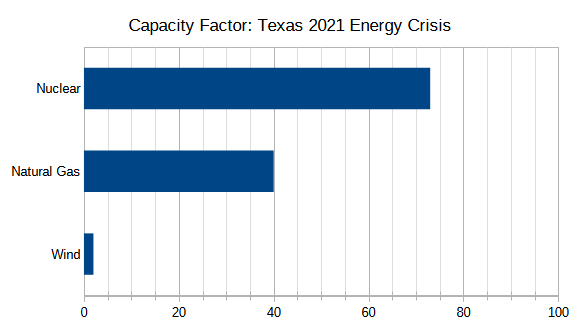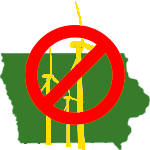In February of 2021, a perfect storm hit Texas. An ice storm caused massive power blackouts, largely due to an ongoing loss of conventional electricity production capabilities combined with wind turbines that were frozen or simply not turning due to low wind conditions. Wind energy companies will tell you that winterization kits are installed on Iowa wind turbines so frozen wind turbines aren’t a problem here. But would they have really made a difference? Not really, because wind conditions were poor throughout most of the country at the time.
 This chart comes from data provided by U.S. Department of Energy, and it clearly shows that wind turbines were largely responsible for the problems. During the worst part of the crisis, Texas nuclear power plants were still operating at 73% capacity. Natural gas plants were at 40% capacity. But wind turbines? They were operating a measly 2% of their capacity.
This chart comes from data provided by U.S. Department of Energy, and it clearly shows that wind turbines were largely responsible for the problems. During the worst part of the crisis, Texas nuclear power plants were still operating at 73% capacity. Natural gas plants were at 40% capacity. But wind turbines? They were operating a measly 2% of their capacity.
Lisa Khory, a resident of Houston who had an auto-pay arrangement with her utility company, woke up one morning to find her checking account nearly drained. The reason? Her electric bill, which normally averaged around $200 a month, had soared to $9,546 to cover the period just from February 1st to February 19th. Scott Willoughby, a resident of San Antonio, was billed $16,752 for electricity in the month of February. And the head of the U.S. Army’s Fort Hood public services commission stated, “I’ve had a lot of fun explaining to people about a $35.9 million dollar bill for the month of February.” That’s right. Fort Hood was billed almost $36 million dollars for electricity for a single month. And who’s on the hook for paying this $36 million dollar bill? Taxpayers, of course.
These problems are not limited to Texas. In September of 2022, California ordered rolling blackouts in the face of record energy demands due to a heatwave. The cause? Over-reliance on unreliable wind power. In fact, the California grid controller had warned lawmakers for years that increasing over-reliance on unreliable wind and solar power was going to put the state at risk of this problem. The lawmakers didn’t listen.
And, no, Iowa is not immune from this problem. In June of 2022, a regional utilities board warned that Iowa and other Midwest states were at risk of rolling blackouts in the summer during extreme heat. In December of 2022, the Iowa Utilities Board issued a warning that the electrical grid was at risk of not having enough power over the winter. This is what happens when you replace 60% of your electricity generation capacity with an unreliable source such as wind.
The conclusion is clear: Wind power is unreliable in both extreme heat and extreme cold—the very times when electricity is in highest demand and when having reliable power is most critical. Wind energy companies claim they will help the economy, but what are the economic costs of having business and industry dead in the water because of rolling blackouts caused by unreliable electricity generating methods?
